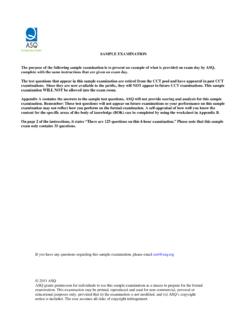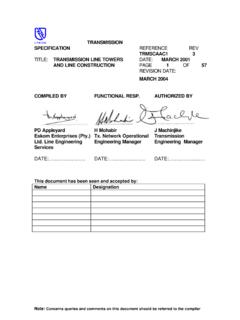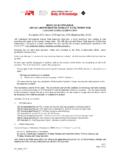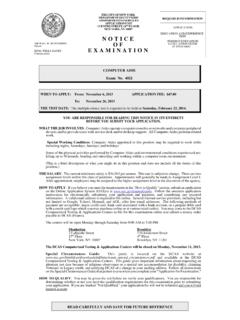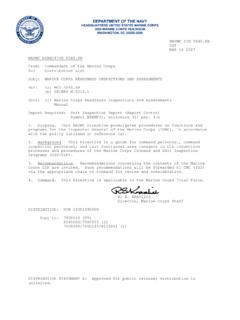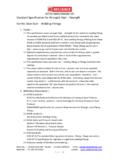Transcription of RESEARCH REPORT 301 - Health and Safety Executive
1 HSEH ealth & SafetyExecutiveReplacement of Radiography by Ultrasonic Inspection Prepared by Mitsui Babcock for the Health and Safety Executive 2005 RESEARCH REPORT 301 HSEH ealth & SafetyExecutiveReplacement of Radiography by Ultrasonic Inspection N S Goujon Mitui Babcock Technology and Engineering Porterfield Road Renfrew Renfrewshire PA4 8DJ This REPORT describes the work performed on the project Replacement of Radiography by Ultrasonic Inspection funded by the HSE. This thirteen months project started in April 2003. The objective was to provide guidelines on the extent to which ultrasonic testing can replace radiography for welds where radiography is currently the preferred inspection method. This REPORT and the work it describes were funded by the Health and Safety Executive (HSE). Its contents, including any opinions and/or conclusions expressed, are those of the authors alone and do not necessarily reflect HSE policy.
2 HSE BOOKS Crown copyright 2005 First published 2005 ISBN 0 7176 2947 3 All rights reserved. No part of this publication may be reproduced, stored in a retrieval system, or transmitted in any form or by any means (electronic, mechanical, photocopying, recording or otherwise) without the prior written permission of the copyright owner. Applications for reproduction should be made in writing to: Licensing Division, Her Majesty's Stationery Office, St Clements House, 2-16 Colegate, Norwich NR3 1BQ or by e-mail to ii CONTENT CONTENT ..iii 1. 1 2. SUMMARY OF WORKSCOPE .. 1 Code Requirement .. 1 Procurement of Appropriate Testsamples .. 1 Manual Trials .. 2 Semi-Automated Trials .. 2 3. LITERATURE 2 Introduction .. 2 Examination by Radiography .. 2 Examination by 6 Radiographic against Ultrasonic NDE Paper Review .. 7 4. CODE REQUIREMENT .. 12 AMSE Code .. 12 British and European Standards .. 21 5.
3 EXPERIMENTAL STUDY .. 28 28 Manual Semi-Automatic Inspection .. 36 6. HUMAN FACTOR .. 38 7. COST .. 38 8. GUIDELINES .. 39 9. CONCLUSIONS .. 41 10. REFERENCES .. 42 iii ANNEXES .. 44 ANNEX A1: CODE REQUIREMENT RADIOGRAPHY .. 45 Review of BS EN 1435:1997 .. 46 Review 48 Normative 48 Acceptance Quality Levels EN 25817:1992 .. 50 Radiographic Technique EN 12517:1998 .. 50 Acceptance Levels EN 12517:1998 .. 50 Guide to the limitations of radiography EN 12517:1998 .. 51 BS EN 13480 Metallic Industrial Piping Part 5: Inspection and 51 Review of the ASME Boiler and Pressure Vessel Code.. 53 QUALITY OF RADIOGRAPHS ASME 2001 Section V (p266)..53 ASME Acceptance 53 General guide to imperfections and NDE methods .. 55 57 ANNEX A2: TESTSAMPLES .. 58 ANNEX A3: SI/08/88: TESTSAMPLE MANUFACTURER S SIZING AND REPORTING 61 ANNEX A4: INSPECTION RESULTS .. 63 Small Bores Testsamples.
4 64 Testsample P8239 .. 64 Testsample P8240 .. 65 Testsample P8241 ..67 Testsample P8242 .. 68 Testsample P8243 .. 69 Testsample P8244 .. 71 Plates .. 73 Testsample 2557-001 .. 73 Testsample 2557-002 ..76 Testsample 2557-003 .. 79 iv Testsample 2557-004 .. 84 Testsample 89 Testsample PL8227 .. 92 Testsample PL8228 .. 94 Pipes .. 97 Testsample P8301 .. 97 Testsample 101 Testsample 106 ANNEX A5: SEMI-AUTOMATIC INSPECTION RESULTS .. 111 REPORT of Semi-Automated Ultrasonic Test .. 112 SMARRT-Scan Data (Defect Images) .. 113 Comparison of the SMARRT-Scan Results with Intended Defect Locations .. 118 Photograph of the Scanner Set-up .. 119 v vi 1. INTRODUCTION This REPORT describes the work performed on the project Replacement of Radiography by Ultrasonic Inspection funded by the HSE. This thirteen months project started in April 2003. The objective was to provide guidelines on the extent to which ultrasonic testing can replace radiography for welds where radiography is currently the preferred inspection method.
5 The two best-established NDT methods used for volumetric inspection of welds are ultrasonic testing (UT) and radiography (RT). There are a number of parameters that influence which of the two methods is selected: technique requirement, accessibility, Safety considerations, tradition, but the two most influential factors are code requirements and economics. One of the main disadvantages of radiography is the potential hazard to Health associated with the ionising radiations which are the basis of the method. Ultrasonic inspection does not have any significant inherent Safety issues and therefore can be more attractive to apply than radiography. However, it is important that the associated Safety and economic advantages are not gained at the expense of reduced confidence in weld integrity. The main objective of the project was to provide guidelines on the extent to which ultrasonics can replace radiography.
6 The project has concentrated on pulse-echo techniques. The factors influencing choice of inspection methods were considered. When the code allows either UT or RT usually the cheapest method, for that particular component, is selected. It is therefore important to consider the economic viability of ultrasonic inspection, even though HSE s main concerns are related to Health and Safety aspects. The project included the assessment of improved or mechanised ultrasonic techniques which provide records of defect images and could speed up the inspection while also improving reliability. 2. SUMMARY OF WORKSCOPE The main aspects of the workscope were as follows: Code Requirement The codes most commonly used in the UK were reviewed and their requirements summarised. Procurement of Appropriate Testsamples Testsamples typical of those types of welds which are currently the most commonly inspected by radiography were manufactured or sourced.
7 A range of realistic defects was incorporated such as slag inclusions, cracks, porosity, lack of fusion, and lack of penetration. Four main categories of weld were represented. These were agreed with the HSE as: small bore pipework, plates 4mm to 15mm thick, 25mm thick plate and 35mm thick pipework. 1 Manual Trials Each of the samples was inspected by standard RT. Since UT and RT are different inspection methods, radiographic acceptance standards are unlikely to be applicable to ultrasonic inspection procedures. The ultrasonic techniques were therefore judged on the basis of whether they were likely to provide at least the same overall level of confidence in weld integrity. Semi-Automated Trials An advantage of radiography over manual UT is the production of a permanent image of defects. Semi-automated UT inspections were therefore also applied. 3. LITERATURE REVIEW Introduction Radiography and ultrasonics are the two generally-used, non-destructive inspection methods that can detect embedded flaws that are located well below the surface of the test part.
8 Neither method is limited to the detection of specific types of internal flaws. However, radiography is more effective when the flaws are not planar, while ultrasonic is generally more effective when flaws are planar. Examination by Radiography General The principle of radiography is that a source of radiation is directed towards an object. A sheet of radiographic film (or other imaging device) is placed behind the object. The density of the image is a function of the quantity of radiation transmitted through the object, which in turn is inversely proportional to the atomic number, density, and thickness of the object. X-ray and -ray radiography are the two main radiographic inspection methods. The choice of which type of radiation is used (x-ray or -ray) depends on the thickness of material to be tested. Gamma sources have the advantage of being more portable and therefore more appropriate for site work.
9 Portable x-ray units are also available with sources ranging in energy from 150keV to 500keV. To maintain a good flaw sensitivity, the x-ray tube voltage should be as low as possible (for the sample thickness under investigation). Also, the field inspection of thick sections can be a time consuming process, because the effective radiation output of portable sources may require long exposure times. Therefore, x-ray field inspection is generally limited to the inspection of specimens of wall thickness less than approximately 75mm. A major disadvantage of radiography is that x-rays and -rays have harmful effects on the body. They are very hazardous. They can not be detected by the senses and have, therefore, legal mandatory requirements, which must be followed and strictly adhered to before and during their use. They have to be used inside a protective enclosure or with appropriate barriers and warning signals to ensure there are no hazards to personnel.
10 Another disadvantage of radiography is that it is not a reliable method for the examination of cracks and planar type flaws. In order to detect these defects, the x or rays need to be directed parallel to the orientation of the defects. It has been proven than when this orientation is greater than approximately 8 degrees 2 then the crack may not be detected. This is a particular problem for weld examination since cracks may lie at various orientations. Compared to other non-destructive methods of inspection, radiography can be expensive. Relatively large costs and space allocations are required for a radiographic laboratory. Costs can be reduced considerably when portable x-ray or -ray sources are used. Operating costs can be high because sometime as much as 60% of the total inspection time is spent in setting up for radiography. With real-time radiography, operating costs are shorter and there are no extra costs for processing or interpretation of film.











